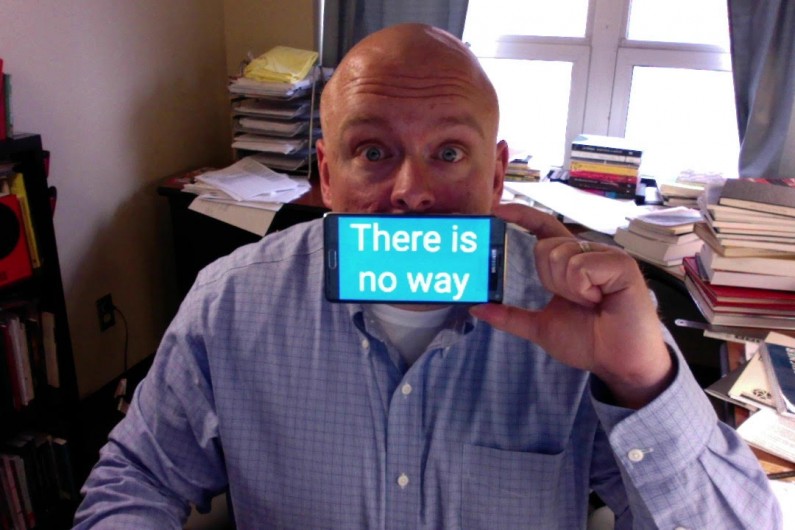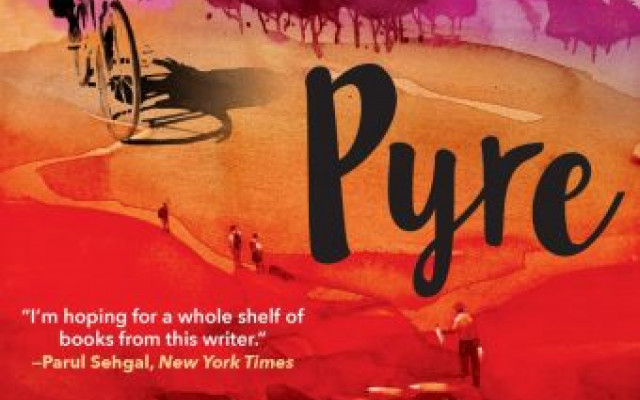Interview: Steve Halle of co•im•press Talks Bilingual Translations

Last fall, I met Steve Halle, the founder and publisher of co•im•press, at a presentation he gave about the press to a gathering of graduate and undergraduate translation students in Madison. At the end of the fall semester, I got in touch and Halle agreed to talk with me as I was preparing a paper about the theoretical implications of various presentations of bilingual books. Halle is not only the founder and publisher of co•im•press (a “micropress that publishes strange, transgressive, or ‘unpublishable’ poetry, prose, and translations by unsung or under-sung authors and translators”), but is also an expert in book design, an instructor at Illinois State University, and a published poet himself.
In this conversation, we talked everything from book design to publishers Halle admires, to the politics of bilingual editions and the benefits of small presses. A most talented—and humble—publisher who must be a dream to work with, Halle is clearly incredibly well connected to the world of translation and translation publishing, and has much to share with translators and readers of works in translation. He’s also got an incredible knowledge of some of the coolest presses publishing translation right now, and 40 minutes with him gave me an unbelievable education.
When I Skyped with Halle, I asked him about a few different types of bilingual presentations that his press has worked with—en face, as well as flip (multi-directional) books—and the behind-the-scenes work that goes into publishing translations of literary works.
—Kelsi Vanada
I especially want to hear your thoughts about Valdivia and the flip book. Or is there another name for it?
The ones I know off the top of my head are the ones that Daniel Borzutzky has worked on—he’s the translator for Valdivia, and also for Raúl Zurita’s books with Action [Books]. If there is a name for that style of book, I don’t know it.
He just won a big award, right?
Yes, Daniel won the National Book Award for his own book, The Performance of Becoming Human from Brooklyn Arts Press. His flip or two-way books with Action are The Country of Planks, which reads in English from the front to the middle, and then Spanish back to front. His other book, Song for His Disappeared Love, also does that, I believe. There might be one other one. It’s something that Daniel advocates for, where it’s front to back, back to front, two books in one. And then I met a publisher at a book fair in Chicago (7Vientos) that does that design style with prose. Daniel and the 7Vientos publisher believe that there are enough Spanish readers that it would double the appeal to be able to have it read like two books in one, as opposed to being an en face presentation. To me, with en face presentations—if you know anything about book design, the way that en face works is that the source language is going to be on the verso page, and the destination language on the recto. The recto is the page of prominence in the design. All the key elements in the book are probably going to appear on the right-side page, as you open the book, as opposed to the back of the page. Your source language is always on the back of the page, so there is some kind of political dynamic to that. I don’t know that most casual readers would even know that that would be a political dynamic. And then of course there are translations that don’t have the source language at all.
Yes—which I feel like in general we are moving away from, but maybe that’s not true.
Not having the source language at all? I don’t think you’re ever going to move away from it, because there are economic reasons for doing it. I really listen to the translator in the publications that I do. Whatever they want to do, or whatever they think is of primary importance for their translation project—I tend to defer to whatever they say. Out of the four translation books that I’ve published so far, two have been en face, one has been the two books in one style, and one has not had the source language in it. It was basically what the translator preferred for all those things—for better or for worse. The one that doesn’t have the source language has been critiqued in reviews for excluding the source. In hindsight, it’s my instinct to include the source language, and I wish I would have been firmer about that, rather than deferring to the translator on that one.
Can you talk a bit more about the economic side of that? I think I remember you saying in your presentation that to produce the flipped book was much more expensive, is that right?
It’s considerably more expensive. So you just have to think about it; the book is going to be approximately double the length. When you’re a press like my press, everything is in relatively small runs at first. Oxen Rage was particularly expensive to do, because the book itself is already very long. I might have mentioned that I’m also working on a Juan Gelman book with Lisa Rose Bradford for a 2018 release called Hoy [Today] which is also very long; it’s a 300ish-page, 288-poem collection, but they’re in little prose blocks, so we’re exploring having them together on the same page and making a little bit of a taller book that can accommodate that, which I’ve seen before with Jen Hofer’s translation of Dolores Dorantes’s book from Kenning and Counterpath, called sexoPUROsexoVELOZ.
So on the same page you get both Spanish and English. Vertically, would you put the Spanish first or the English?
That’s a great question. sexoPUROsexoVELOZ has Spanish on top, English on the bottom, and some interesting design elements that kind of separate the page. I was able to experience it as a typical book because there is content on every page, so it worked for me. I don’t know if the Gelman book will be exactly like this, but it’s definitely something that has me thinking in a different way about what’s possible. I probably would follow the lead of a book like this. Having the source language first is important—I don’t think it would disturb the reading experience in any way. But I’d also see what Lisa wanted to do. She might want to have the English on top.
I’m interested in that as an element—the reader’s experience. When I was at the ALTA conference in October, Jen Hofer was talking about translating the book Style by Dolores Dorantes. This book has the first half in Spanish, and the second half is all of the English poems. She said she didn’t feel like the sequence should be broken; you shouldn’t be switching between languages while reading. I’m curious about this because some readers are just going to skip the whole first half of the book if they don’t have access to the Spanish.
Did you hear her talk about the Virginia Lucas book that she’s working on, at all, Amé.RICA?
I think she was talking about that a bit.
This is one of the many things that I think is so great about Jen Hofer. She very much takes the projects she’s working on on a book-by-book basis. She thinks about the work of translating a text in a similar way to how I would as a publisher. So I’m not just getting locked into a particular systematic way of going about doing things. The Lucas book is going to be heavily footnoted. It’s an interesting counterpoint to the Dorantes Style book, which you can read through without any footnotes. Because Amé.RICA is going to be heavily footnoted, to the point where the footnotes are probably going to seem excessive and create a para-text within the sphere of the translation. But the author she’s working with is really in favor of the way that Jen is doing the translation, even though it’s going to be an experimental style of footnoting that’s going to break up the work a bit and make the translator’s presence more visible. I’m really excited about that book; I just think it’s really interesting that she takes so many different approaches from these projects and is able to find presses that are able to support the ideas—which I think are compelling ideas—behind doing it in a particular way for each particular book.
Which is what you’re doing too, it seems, based on the translator’s input. Are there different reader experiences that you could speak about with each of the translated books that you’ve published? Do you hope that a reader of Valdivia is flipping back and forth to see how the translation is done? Or is it more about having two separate audiences?
I think that’s what Daniel wants for it, so I also hope that that’s correct. A lot of it comes out of his politics as a scholar, author, and translator. I don’t know if you’ve read his Memories of my Overdevelopment (Kenning Editions). It’s creative work, and also transcripts of presentations that he’s given and essays that he’s written. But he has a politics where Chicago is a Latin American city—being in Chicago, I think he really considers the Spanish-first populations that are living in Chicago. He has the belief that in the US there is a reading population that’s going to be interested in having the Spanish language first, and he is committed to respecting that audience’s presence, instead of ignoring them. I am, too. Having uninterrupted source text also gives the book an interesting kind of second life in its source country, because the rights for Latin American authors are much different than they are here—I’ve heard that in Latin America, if the rights don’t revert to the author upon publication of the book, authors are unlikely to publish with those particular houses, so the authors have a lot of control over their own work. It’s less expensive for translation houses to support translation projects for Latin American writers, because they have the rights to their work. That’s also the case in Spain for most presses, from what I understand. So that means you can bring back this other edition where the book’s been translated, but it also gives it an interesting second life for the author in Spanish-speaking countries. Which is kind of intriguing. But I’ve also heard dissenting viewpoints from other people—I felt like these were cold and disparaging viewpoints—but I’ve heard that a lot of people use the term “kitchen Spanish” for people who just speak Spanish with their family in the home and wouldn’t be able to read literature in Spanish. Sort of disparaging the same audiences that Daniel is trying to support, so I tend to agree with Daniel that there are Spanish readers out there who can benefit from books that have the Spanish and English in separate section rather than en face. I think Valdivia is a book—one of the differences between Daniel and Lisa’s hopes for their books as translators is that Lisa was interested in the possibility of Oxen Rage being used as a text for people who are studying translation, because the Gelman work is so difficult to translate into English or any other language, and that’s the only translation of that book into any other language, despite Gelman’s worldwide fame, though he’s still criminally overlooked in the US. Her reason for wanting an en face translation was with the hopes that people would use that book also in translation programs, in addition to people wanting to read it for scholarly and literary reasons.
Cool!
And I think that Valdivia would be much more difficult to use in a translation program, just because of the logistics of having to flip, and what matches up with what number-wise. I can’t remember if all the page numbers match up. In order to make the page count line up, I think I had to drop a front matter page from the Spanish version, so the page numbers might not line up exactly. I also think a lot of small presses might not have the know-how to make a flipped book like that. It does take a couple extra steps. You have to map the pages a little bit differently to make sure they match up just right. It’s really like doing two different layouts—you have to do one layout for the Spanish, one layout for the English. And then you have to know how to do some advanced techniques in Adobe Acrobat Pro to combine the pdfs before you go to print. And so, I’m friends with Andrew Shuta, who designs books for Action, who did The Country of Planks, he did that all manually in InDesign, which probably took him hours and hours. You know, InDesign doesn’t support experimental layouts like that—you have to do each page by hand and rotate the text and reconsider the margins for the upside-down text. You have to find another way to automate it. I came up with a way using Acrobat that he didn’t know how to do, or hadn’t thought about, when I asked him for advice about how to do the two-way book like Country of Planks. And so, after I figured out the method for it, I emailed it back to him. I’m sure he’s angry that I figured out a shortcut!
All that work! So in that sense, you’ve studied, or have taught yourself book design—and you do this for other presses too—you showed us a lot of examples of books that you’ve designed for other publishing houses. So to what extent does your training in design affect the editions you can produce?
Definitely it affects it. I don’t feel like there’s any kind of book project that I wouldn’t be able to pull off. Certainly that opens a lot of doors, like I’m not afraid of the labor that it takes to do certain kinds of experimental poetry where it’s using the whole page or is really visual. I have no difficulty doing the extra work to map that out and make it right. Oftentimes it involves a lot more collaboration with the author, in projects that I work on or that I freelance for, but I think most authors are willing to trust my judgment on it. I worked on this one really complicated book called Theories of Forgetting, it’s from FC2 by Lance Olsen, and it’s a multi-directional book with interwoven narratives including text, images, and marginal notes—not unlike Valdivia, but it’s more complex than that layout is. Lance had basically written the book in InDesign and mapped out it’s look, and it was my job to get what he had designed print ready, which means I worked closely with Lance and got pretty close to the experimental layout. After that project, I feel like if I have enough time, I can pull off most anything I want to pull off! Obviously, that makes me more comfortable with the projects for co•im•press. Also, I teach publishing; that’s what my day job is, working in the Publications Unit in the Department of English at Illinois State. I have a creative writing background and a publishing background, so I get to bring both knowledge bases in on complicated designs.
So, if you had no restrictions based on budget or time, is there some format for works in translations that you have envisioned without those restrictions? Maybe even thinking toward digital editions? I know there are things that have been tried that way—like on Asymptote, you can hover over a footnote and it pops up a window so you don’t have to look down to get the footnote. You seem like quite a visionary—is there a project that would be great if you had everything you needed?
Projects I’ve seen that spring immediately to mind—it would all, for me, really depend on what the source project is and what the translator wants to do—but there’s a small press called Siglio Editions, where you get a physical book but there is a digital component to it. The book has something similar to QR codes. What you do is, you go to a certain website which has an app that’s pre-loaded on it, so you hold these things up to the camera on your computer and it will render some kind of dimensional text that will shift around. I think stuff like that is really cool. I have a couple chapbooks from Plumberries Press that come in pieces, in an envelope that you take out. It’s cool, but also more costly to do that kind of stuff. Have you heard of the press Visual Editions?
I don’t think so.
They’re probably most famous for Jonathan Safran Foer’s Tree of Codes; it looks like a regular book, but you open it up and there’s die cutting, so you see into the book, and it changes as you go through. So there are certain words on certain pages, but you can see through the die cuts onto other pages. Stuff like that is intriguing, it opens up so many possibilities for publishing. There is stuff that’s done with semitransparent paper that I think can be really cool. You know, as far as a special edition book, where you could have things on their own page, but you could see something through it, but you’re maybe vaguely seeing it. That stuff would be of interest for translation projects. A big part of translation publishing is that there is so much out there that you don’t know about. I’m not a translator or comp lit scholar, so I don’t feel like I’m tapped in particularly well to any other nation’s literature or even scratching the surface in what I know about or can read in world literature, although publications like Asymptote are really helpful in that regard. I’d love to work on projects like that and find some enthusiastic patron to give me a lot of money to support the effort.
Another question I had, and maybe this seems a bit obvious, but we’ve talked about this idea of the visibility of the translator—I think this is changing now, but for such a long time in the history of translation, the “good” translation was the one that you couldn’t tell was a translation, that read very fluidly, and I think most translators and most publishers of translation would want to acknowledge the work that the translator has done. For me, a book where you have to confront the two languages does exactly that; it reminds you all the time that you’re reading a translation. So I don’t know if there is a question in this exactly, but in terms of reader experience again, do you hope that the reader is reminded often that they are reading a translation? Is it more important to you that they’re just having a good reading experience? What kind of visibility or not do you want the translator to have? It sounds like you do a lot of projects where you care about the translator having a part in the way it all works out. Sorry, not a very good question.
No, it’s a great question, because I thought of a million things while you were talking.
Oh, good!
I think that this question is probably rooted in Lawrence Venuti’s work.
Right.
Even though I’m not a translator, I did work with a translator, Kristin Dykstra, who’s an editor for the journal Mandorla that I might have talked about a little bit when we met previously. It was part of her mission, knowing that I come from a creative writing and publishing background, to make sure I knew what it was like for translators, and what the political arguments are like about translation, other than the lack of it, even within the field itself. She made me read excerpts from Venuti’s book, so then I started to get it. And it’s sort of like anything else in publishing, where it takes somebody to call your attention to it and then suddenly it’s everywhere. With brand-name authors that are translated, the translator definitely gets lost in the shuffle. I’m thinking of Murakami, or Bolaño—with things that come out from bigger presses, the translator gets othered more than things from small presses, it seems. I think that there are a lot of reasons for that. Víctor Rodríguez Núñez and Katherine Hedeen were talking about this sort of like—I don’t know if it was a literary conference in Havana, in the wake of the US thaw with Cuba, but some of the big publishers were down there just to find hungry—literally and figuratively hungry Cuban writers—and just exploit the possibility of being able to get them translated and use house translators to push the work out. There’s sort of still gross kinds of exploitative things happening in translation. I feel like it’s less likely or, at least, less egregious on the small press level. I know I’m not getting rich off of books, I know what the process is like for translators, and a project would not exist without the work that a translator’s doing. Without translators I could only read—very laboriously and without comprehending the nuances of the poetry—in Spanish. And the kind of literature that I seek out would be really complicated to read as a Spanish-language reader without fluency. So I empathize with what it takes to pull off a translation project. The politics of making sure the translator is treated like an author is really important, at least for the translation publishing projects that I do. But yeah, there’s a lot of stuff where the translator’s name doesn’t appear on the cover. Who are some other big authors like that—Ishiguro, I believe, the translators names don’t appear on the covers of editions of his books.
I was interested in your knowledge of what the rest of the publishing industry for translation might say—it sounds like you’re in constant contact and discussion with other publishers of translation. Is there anything else about publishing bilingual editions that you learned from someone else in the industry? Or what kind of secrets get shared?
I mean it’s really just that much less often will it occur with prose. That’s probably a hard core economic decision for prose. But prose is also situated as a genre much differently—or as a set of genres—much differently than poetry is. One other thing that I was going to say is that Ali, the translator for I Am a Face Sympathizing with your Grief: Seven Younger Iranian Poets, that brief anthology, his big thing was that he wanted a book that would appeal to American readers, and he had selected these internet poets from Iran who weren’t part of the poetry establishment by any stretch of the imagination, and I felt like he wanted the book to be read alongside contemporary American books, even though it is a translation. And I don’t mean this in a colonial sense but more in the way that younger poets of a certain age are engaging with poetry in comparable ways, perhaps, despite the nations themselves being rivals. He and I have had talks about how we really feel like there are two Irans and two United Stateses. There’s the way that the world would perceive the United States—I try to do thought experiments about how it would be perceived, which I think in a post 9/11 world, if you don’t behave like that you fall into all the traps that we as a country have now seemed to have fallen into—and all the dark things historically that happened because of demonizing other cultures and other nations for political purposes. I think that happens for Iran, so one of the goals that we had for doing that short anthology was to say, more or less, there are two Irans or that Iran and its poetry is more diverse and nuanced than what we might think or what we are coached to believe. There’s the Iran that media or politicians want you to see, but then there’s another one where there’s artists who are more or less the way certain groups of Americans look at ourselves as artists or scholars, who are doing different kinds of work that isn’t accepted by the establishment or sometimes even published—I think some poems were published in the anthology first because they couldn’t be published in Iran—and who aren’t a part of the media or political narrative about Iran. Iran is a huge country, there’s lots of different coteries that seem divided, not unlike here. Just to have a book that implies that statement was really important to us. And so that was another reason that he didn’t want the Farsi originals to appear in there.
That’s super interesting. I’m thinking on that domestication/foreignization continuum—whether a translation foreignizes to the point where you have to go way over there to meet the text, you know it’s a translation, and it might be unsettling to you; versus domestication, where the translation comes to you in a way.
I think it matters too how much a language is translated, and how much comes from a particular country. European romance languages, to my mind, get to have a lot more experimental, edgy translations, because people who would be stakeholders in reading those translations would have a passing familiarity with the literature, in a way that if it’s a book from Iran, people are still thinking that Rumi, that Omar Khayyam are the only Persian poets that they know about, so those kinds of books that are disruptive translations could be perceived in different ways. I heard a talk from Johannes Göransson who recently co-translated this book called Cheer Up, Femme Fatal by Kim Yideum with Don Mee Choi and Ji Yoon Lee. It was a project that originally Ji Yoon was working on by herself, I think, but then Don Mee and Johannes got involved in it. Johannes doesn’t have Korean, so it was up to Don Mee and Ji Yoon to English the book, but then there were lots of complicated discussions about the politics of translation, because Ji Yoon was very in favor of keeping the book as weird in English as it is in Korean, but Don Mee, I guess, said that Korean literature in the United States is still emerging, still gaining acceptance as literature worthy of being read, and it would be taking too much of a risk to keep the strangeness of a language with its linguistic and grammatical attributes intact when you translate. And it’s different from country to country and culture to culture—you never know what the first point of engagement is going to be with the reader. You could, in theory, turn off a reader from reading things from a culture, just because the language remains so estranged in translation. I think that that has to be taken into account, that that kind of thing is different for a book translated from Korean than it might be from a book translated from German or French.
Where you could potentially push the boundaries a little more because you’re not going to lose a readership for French translation or something.
Yeah, or if you’re going for translating the edgiest writers from a certain country, like my press would be, or Action Books, that also has implications. If you’re going for the most intriguing, compelling, or edgy writers from a culture that has been under-translated, that has implications and possible consequences as well. You don’t want to alienate a potential readership from a country’s works because you’re publishing the most risky and avant-garde things from that country, which could backhandedly reinforce negative narratives that the media or government has about these other cultures. I think that’s definitely at stake in the Iranian anthology. The poetry in the anthology is not, to my mind, what most readers would think is representative of Iranian poetry or Middle Eastern poetry. Ali and I both have an interest in breaking down the expectations people have for Iranian poetry but not in such a way that alienates readers or reinforces unfortunate or untrue perceptions of the culture.
That’s such a responsibility for the translator—what portrayal of that culture and country comes through in your translation.
Those are real concerns. It’s difficult to be able to manage all that. There are so many writers here, and then you have to weigh the translation project against the contemporary work being done in the genre in the destination language, and that gets complicated and requires a really developed sensibility and judgment.
I don’t think I have any other questions, but I appreciate you chatting with me about some of your thoughts around these different editions. As a new translator, it’s so exciting to hear that the translator is included in the decision-making process and heard in the way that your books are presented.
That’s true for small presses, mainly, but the more the work gets distributed, like it might be at a larger trade house, I think it’s less the case.
I really appreciate your help! Best of luck with everything, and thanks for your time.
Of course! This was a lot of fun.
Interview transcribed in December 2016 and edited in March 2017.



